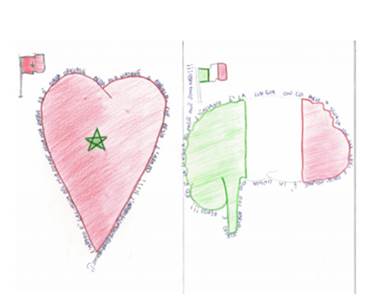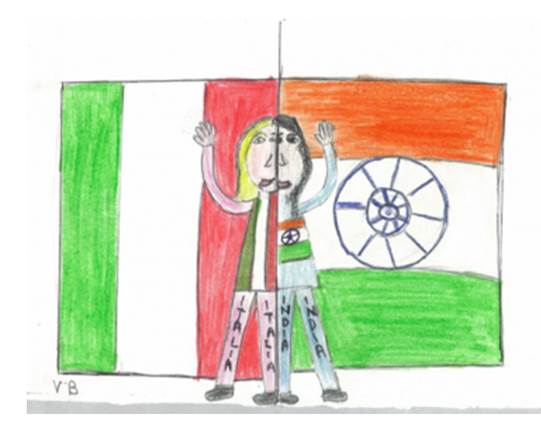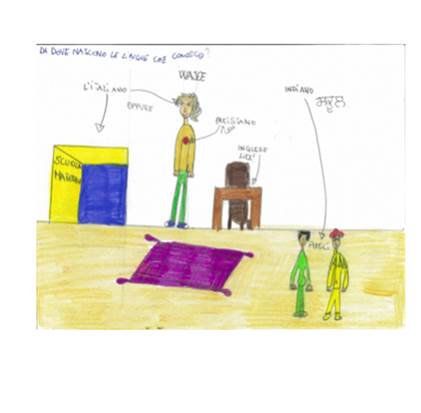My multi-lingual self: Children's language self-portraits
Children in Italy were asked to draw pictures of themselves and their languages. See some examples.

| Сайт: | Isotis |
| Курс: | Promoting multilingualism in the family |
| Книга: | My multi-lingual self: Children's language self-portraits |
| Надруковано: | Visitante |
| Дата: | Saturday 13 September 2025 16:47 PM |
1. Introduction
If we ask children to make drawings about themselves and their languages, we can start to see how complex issues of multilingualism are. In an Italian research study, children were asked to make drawings of themselves and their languages. The children were also asked to talk about their drawings. You can see some examples on the next pages.
2. 'SPLIT INTO TWO'
P. is from India. She lives in Italy.
She draws the Italian flag on the left side. As an Italian she has blonde hair. She draws the Indian flag and national symbol on the right side. As an Indian she has black hair.
She says: “I am half Italian and half Indian.”
3. 'HEART VS BRAIN'
One boy is from Morocco. He lives in Italy.
He draws a heart for Morocco and writes:
“Arabic is the language of my heart. … It is the official language of my country, Morocco. ...”
He draws a brain for Italy and writes:
“Italian is the language I speak at school, with friends and teachers. It is the language I use to speak, to write, and to think. And it is the language of the country I was born in.”
4. 'MY LANGUAGE LOCATIONS'
Another boy includes four languages in his picture.
He calls his mother tongue ‘Pakistani’ and places it in his heart. He speaks his mother tongue at home. He draws a carpet to represent his cultural background.
He places Italian in his head. It is the language he learned from his teacher in nursery.
He learned English in school. He represents English with a school table and a chair, and the school gate.
He draws two boys. He labels them with language which he calls ‘Indian’. He has learned this language from his best friend.
5. 'MY PLURILINGUAL BODY'


One girl is from Pakistan. She lives in Italy.
She learned to read and write in Italian. She draws the Italian flag on her right hand. “… because I always had an Italian book in my hand.”
She uses her heritage language at home. It is her mother tongue. She draws the flag of Pakistan on her tongue.
She draws the English flag in her heart. “… because I really like English and I will soon be moving there.”
She draws the flag of Spain in her legs. “ …. Because I am learning Spanish”. She says that she has a long way to go, but in the future she will speak it perfectly.
6. Resource: Link
These children took part in an Italian research study. Here is a link to the paper where the drawings and descriptions were published
7. QUESTIONS TO STIMULATE GROUP REFLECTION
Looking at those examples of drawings can help to initiate a group discussion which encourages reflection about the language situation in the family, and participants’ feelings connected to the different languages. Questions that can be discussed in the group are:
With a focus on the case:
* What do you think about these drawings and the ways the children describe their pluri-lingual worlds?
* What do these children think and feel about their languages?
With a focus on the participants' experiences:
* What are the languages in your life?
* Are your languages connected to certain places or people?
* Are they connected to certain times/phases in your life?
* How do you feel about the languages in your life?
* Were there any changes in how you think and feel about your languages over time in your life?
* Have you ever spoken to other people about your languages and what they mean to you?






